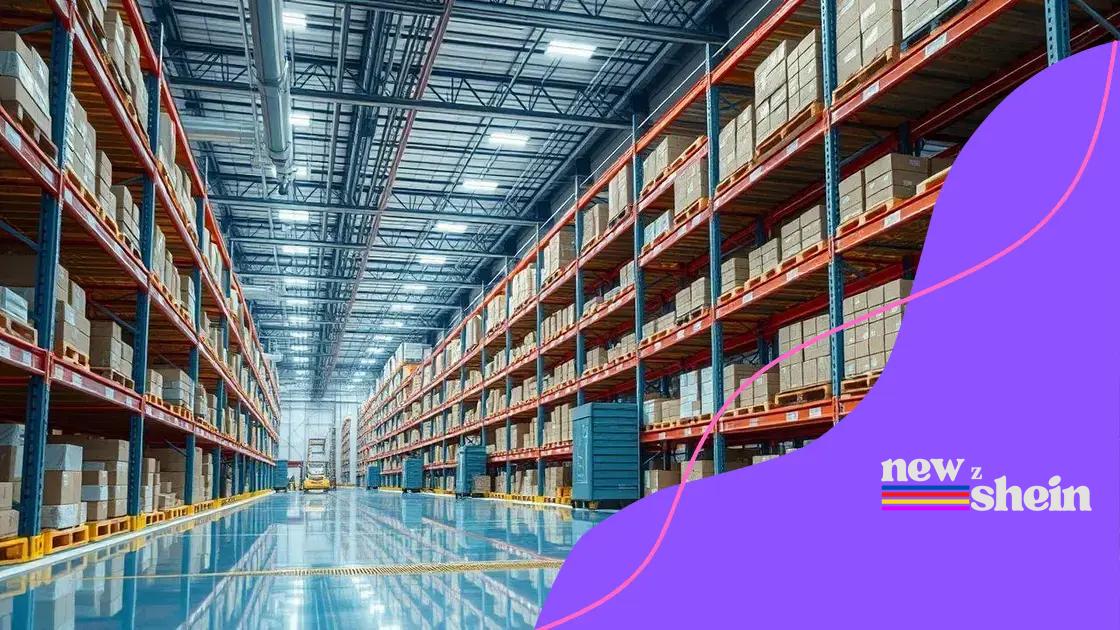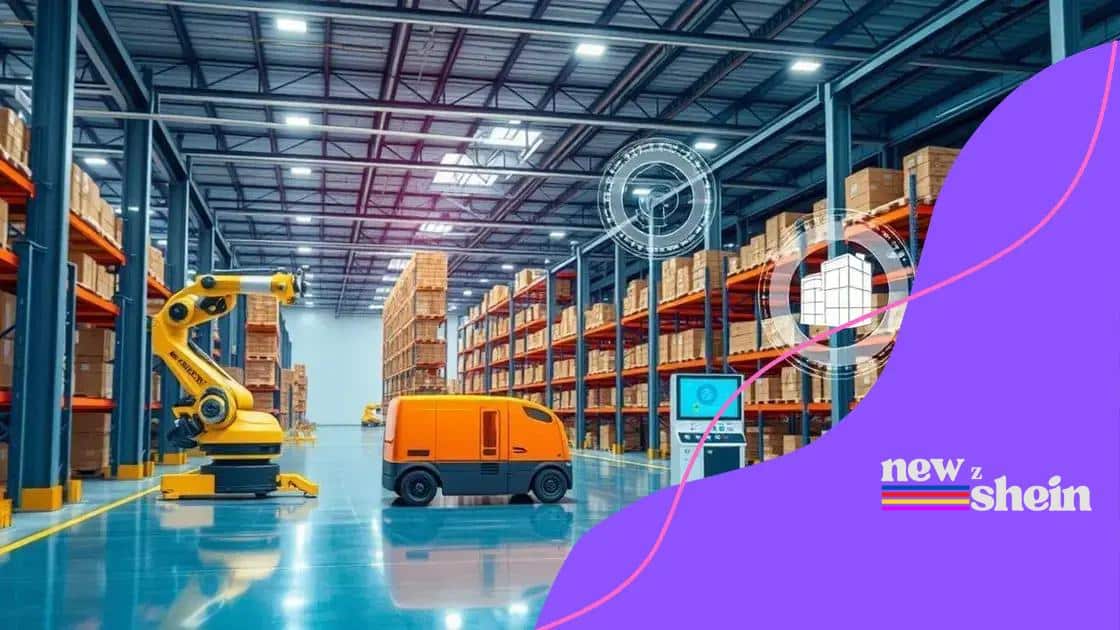Shein’s warehouse automation technologies: a game changer

Shein’s warehouse automation technologies enhance efficiency and accuracy in logistics through the use of AI, robotics, and IoT, leading to faster order processing, reduced costs, and improved resource management.
Shein’s warehouse automation technologies are transforming the logistics landscape, driving efficiency and enhancing accuracy. Have you ever wondered how these innovations streamline operations? Let’s dive into this fascinating world of automation.
Understanding warehouse automation technologies
Warehouse automation technologies play a vital role in modern logistics. These innovations not only enhance efficiency but also improve accuracy in operations. Understanding these technologies is key to grasping how companies optimize their warehouse processes.
Types of Warehouse Automation Technologies
There are several types of warehouse automation technologies that companies like Shein implement. Each technology has unique capabilities that enhance productivity.
- Automated Guided Vehicles (AGVs)
- Robotic Picking Systems
- Warehouse Management Systems (WMS)
- Conveyor Systems
These technologies work synergistically to streamline warehouse operations. For example, Automated Guided Vehicles navigate through the warehouse, transporting goods without human intervention. This not only speeds up the process but also reduces human error.
Benefits of Implementing Automation
Implementing automation technologies brings numerous advantages. Companies witness a remarkable boost in operational efficiency and cost savings. By automating repetitive tasks, employees can focus on more strategic roles.
Additionally, automation leads to improved accuracy in inventory management. With real-time data tracking, businesses can maintain optimal stock levels and reduce waste.
Overall, understanding warehouse automation technologies equips businesses to leverage these advancements for enhanced performance and competitive edge in the logistics industry.
Benefits of Shein’s automation systems
Implementing Shein’s automation systems has brought remarkable benefits to the company. These systems enhance productivity and streamline operations, allowing Shein to meet the high demands of the fast-paced fashion industry.
Increased Efficiency
One of the primary advantages of automation is the significant increase in efficiency. Automated systems can process orders much faster than manual methods. They reduce time spent on repetitive tasks and allow employees to focus on more critical aspects of the business.
- Faster order fulfillment
- Reduced manual errors
- Improved inventory management
This efficiency allows Shein to respond quickly to market trends and customer needs. As a result, customers enjoy faster shipping and timely delivery of their favorite products.
Cost Savings
Shein’s automation systems also lead to substantial cost savings. By minimizing labor costs and maximizing resource utilization, automation can significantly lower operational expenses.
Automated technology reduces the need for a large workforce while still maintaining productivity. This savings can be redirected into enhancing product quality and expanding the product range, ultimately benefiting customers.
Moreover, automation in warehouses reduces wastage, leading to further cost efficiency. Effective management of resources through automation ensures that materials are used wisely and efficiently.
This focus on practical advantages makes Shein’s automation systems not just beneficial but crucial for sustaining growth in a competitive retail landscape.
Key technologies used in Shein’s warehouses

Shein leverages several key technologies to enhance its warehouse operations. These innovations are crucial for ensuring smooth logistics and efficient order fulfillment. Understanding these technologies provides insight into how Shein maintains its competitive edge in the fashion industry.
Robotic Picking Systems
One of the standout technologies in Shein’s warehouses is robotic picking systems. These robots can accurately select and pack items, significantly speeding up the order fulfillment process.
- Reduced labor costs
- Increased accuracy in picking
- Greater speed in processing orders
By using robotic systems, Shein can manage large volumes of products and ensure that customers receive their orders promptly.
Warehouse Management Systems (WMS)
Another essential technology is the Warehouse Management System (WMS), which tracks inventory, manages orders, and optimizes warehouse layout. A WMS improves the overall efficiency of warehouse operations.
This system enables real-time inventory tracking, reducing the chances of stockouts or overstock items. It automates various administrative tasks, allowing employees to focus on more critical functions.
Additionally, the WMS integrates with other systems, creating a seamless flow of information between sales, inventory, and logistics. This connectivity is vital for a data-driven organization like Shein.
Automated Guided Vehicles (AGVs)
Automated Guided Vehicles (AGVs) are also key players in Shein’s automation strategies. These unmanned vehicles transport goods throughout the warehouse without human intervention, enhancing operational efficiency.
AGVs navigate the warehouse floor by following designated paths, which reduces the risk of accidents and improves the safety of warehouse operations. They automate repetitive tasks, allowing human staff to take on more strategic roles.
Combining these technologies enables Shein to optimize its warehouse processes, enhancing performance and ensuring customer satisfaction.
Impact on supply chain efficiency
The impact of Shein’s automation technologies on supply chain efficiency is significant. These advancements streamline operations and ensure that products move quickly from warehouses to customers.
Faster Order Processing
One major effect of automation is the speed at which orders are processed. With automated systems in place, Shein can handle a large volume of orders simultaneously. This allows them to deliver products to customers faster than ever before.
- Minimized handling time
- Increased order accuracy
- Improved response to market demand
As a result, Shein can more effectively meet customer expectations for quick shipping and availability.
Real-Time Inventory Management
Another crucial aspect is real-time inventory management, which is made possible through advanced technologies. Automated systems keep track of stock levels and alert managers when items need to be restocked.
This capability reduces the risks of stockouts and overstock situations, ensuring that Shein always has the right products available. Efficient inventory management leads to better resource allocation, ultimately enhancing the supply chain’s performance.
Cost Efficiency
Automation also contributes to cost efficiency within Shein’s supply chain. By optimizing processes and reducing labor costs, Shein can allocate resources more effectively and improve profitability.
With lower operational costs, Shein can offer competitive prices, benefiting both the company and its customers. These savings can also be reinvested into improving technologies and expanding product offerings.
In summary, the impact of Shein’s automation technologies on supply chain efficiency is substantial. From faster order processing to better inventory management and cost savings, these advancements play a crucial role in the company’s success.
Future trends in warehouse automation
The future of warehouse automation is promising and filled with innovative technologies that are set to transform how warehouses operate. As businesses like Shein continue to evolve, staying ahead of trends is essential.
Increased Use of Artificial Intelligence
One major trend is the increased use of artificial intelligence (AI) in warehouse operations. AI can analyze large amounts of data, predicting trends and optimizing inventory levels. This capability allows warehouses to function more efficiently.
- Improved demand forecasting
- Automated decision-making
- Enhanced predictive maintenance
By integrating AI, warehouses can reduce costs and improve service levels for customers.
Expansion of Robotics
Another significant trend is the expansion of robotics. Robots will play an even larger role in picking, packing, and transporting goods within warehouses. The use of collaborative robots or cobots will increase, working alongside humans to enhance productivity.
These robots can perform repetitive tasks, allowing workers to focus on more complex duties. This collaboration leads to more efficient workflows and safer working environments.
Integration of IoT Technologies
The integration of Internet of Things (IoT) technologies will also shape the future of warehouse automation. IoT devices will enable real-time tracking of inventory and equipment, offering valuable insights into operations.
By implementing IoT systems, warehouses can monitor conditions and performance metrics continuously. This leads to better management of resources and quicker response times to issues.
Sustainability Initiatives
Finally, future trends will include a stronger focus on sustainability. Warehouses will adopt eco-friendly practices, such as energy-efficient systems and sustainable materials.
Businesses are becoming more aware of their carbon footprint and the need for responsible practices. Implementing green technologies not only benefits the planet but can also lower costs in the long run.
In conclusion, the future of warehouse automation will be defined by advancements in AI, robotics, IoT, and sustainability. These trends will lead the way for more efficient operations and improved customer satisfaction in the logistics industry.
Conclusion
The advancements in warehouse automation significantly enhance efficiency and effectiveness in supply chain management. With technologies like AI, robotics, and IoT, companies are optimizing their operations, leading to faster processing times and reduced costs. Furthermore, these innovations contribute to a more sustainable approach to logistics, ensuring that businesses can meet customer demands while being environmentally responsible. As we look toward the future, embracing these trends will be crucial for any company aiming to stay competitive in an ever-evolving marketplace.
Here’s a brief summary of the key benefits of warehouse automation:
FAQ – Frequently Asked Questions about Warehouse Automation Technologies
What are the main benefits of warehouse automation?
The main benefits include increased efficiency, reduced costs, improved accuracy in order processing, and better resource management.
How does AI improve warehouse operations?
AI enhances warehouse operations by enabling real-time inventory management, optimizing workflows, and predicting customer demand.
What role do robotics play in warehouse automation?
Robotics streamline tasks such as picking, packing, and transporting goods, allowing for faster processing and less reliance on human labor.
What trends can we expect in warehouse automation?
Future trends include the increased use of AI, expansion of robotics, integration of IoT technologies, and a stronger focus on sustainability.





